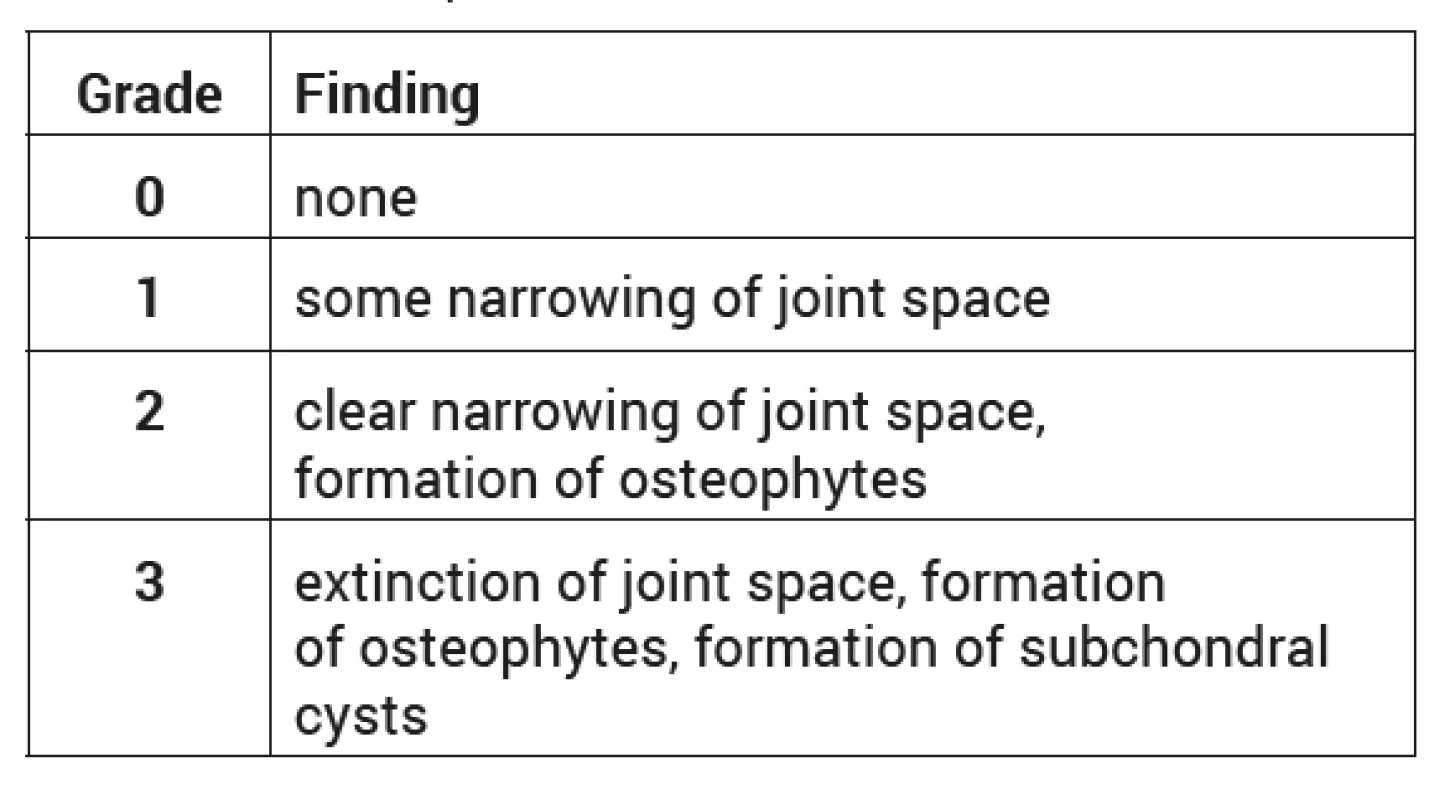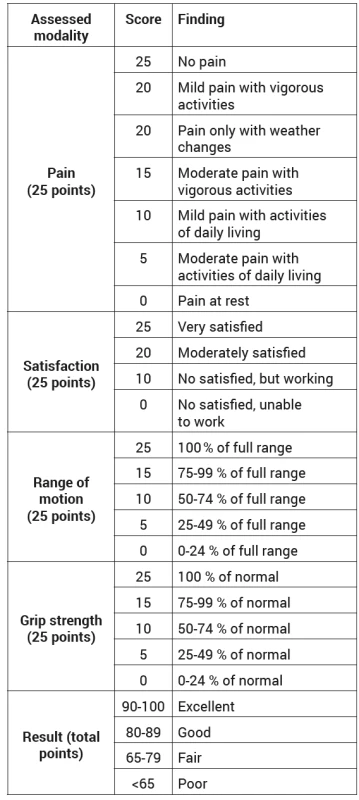Radiocarpal arthrosis after intraarticular fractures of distal radius
Authors:
Tomáš Ninger 1; Radek Hart 1,2
Authors‘ workplace:
Nemocnice Znojmo, p. o. Ortopedicko-traumatologické oddělení
1, 2Úrazová nemocnice v Brně, Klinika traumatologie LF MU Brno
1
Published in:
Úraz chir. 27., 2020, č.3
Overview
Objective: To determine how often arthrosis develops after a distal radius injury and whether it causes significant clinical problems.
Introduction: Arthrosis is a non-inflammatory chronic joint disease that can result in serious clinical problems. Most of the arthroses develop on a traumatic basis; idiopathic causes are rare. Radiocarpal arthrosis is manifested by pain in motion, limitation of the range of motion, and reduced handgrip strength.
Material and methodology: Patients with a follow-up period of at least 10 years after intraarticular fracture of distal radius were included in the retrospective study. Patients with type C fractures according to AO classification were selected for the evaluation. Patients with ossis scaphoidei nonunion and after inadequately treated scapholunate ligament rupture were excluded. The evaluation of post-traumatic arthritis was performed according to the Knirk and Jupiter scale, clinical assessment according to the Modified Mayo Wrist Score.
Results: In 2007 and 2008, 749 patients with distal radius fractures were treated, 112 of them with type C according to AO classification. The average age at the time of the fracture in an intraarticular localisation was 53.2 years. 31 patients were invited for a check-up after 11–12 years; a form of radiocarpal arthrosis was diagnosed in 10 of them (32.3 %). The average score in patients without arthrosis was 92.1 points out of 100, in patients with a certain form of arthrosis it was 69.5 points out of 100. Poor clinical outcome was observed in 3 patients with radiocarpal arthrosis. During the reference period, radiocarpal arthrosis developed in 8 patients with a distal radius articular surface deficit of more than 2 mm. None of the patients with radiocarpal arthrosis required surgery.
Discussion: In a study by Swedish authors, arthrosis developed in 38 out of 63 monitored patients; the arthrosis did not affect the functional outcome. During a 15-year follow-up of authors from the USA, all 16 patients developed arthrosis after the osteosynthesis of intraarticular distal radius fracture. The functional results did not relate to the grade of arthrosis either. In their thesis, Knirk and Jupiter describe the development of arthrosis in 91 % in 6 years after the intraarticular radius fracture surgery. 52 out of 66 patients in another study from Sweden achieved a good functional result in 9–13 years regardless of the type of fracture; arthrosis developed in one of them only.
Conclusion: Fractures of the distal radio, interfering with the radiocarpal joint with a deficit of more than 2 mm, represent a major risk factor for the development of post-traumatic arthrosis, leading to painful restriction in wrist function. Despite this finding, however, wrist function is often acceptable to patients, without the need of indication for surgery.
Introduction
Wrist arthrosis is a non-inflammatory chronic joint disease characterised by degenerative changes in the cartilage, which can result in serious clinical problems such as pain or restriction in motion and strength in the wrist area. Most of the arthroses here develop on a traumatic basis. These may be secondary ones after scapholunate ligament ruptures followed by changes in the arrangement of wrist conditions [21], after intraarticular distal radius fractures or in the case of ossis scaphoidei nonunion. Idiopathic causes are rare; they include, for example, avascular necroses of the wrist (m. Kienböck, m. Preiser) or, for example, congenital wrist abnormalities (Madelung deformity) [25, 27].
Radiocarpal arthrosis is manifested by a fairly clear clinical picture - pain in motion, restriction in the of motion, and reduced handgrip strength. These symptoms creep in, but can deteriorate rapidly after another injury or overload. Another finding may be the swelling, mostly dorsally, developing on the basis of synovitis. In wrists with severe changes, radial translation may be considerable [11, 16].
The incongruity or dorsal tilt of the articular surface of the distal radio causes increased pressure and its uneven distribution, leading to cartilage overload and development of arthrosis [24]. Intraarticular comminuted fracture with the palmar ulnar, dorsal ulnar and radial fragment often results in excavation of the articular surface. If both ulnar fragments are insufficiently reduced, then the impression of the central part of the articular surface may not even manifest itself in an incongruity [13, 17].
Although post-stress arthrosis arises particularly on the basis of mechanical disparities, individual differences in the likelihood of its formation and the rate of deterioration remain unexplained [18].
Motion in terms of usual daily activities comes from radial abduction/adduction and dorsal extension to ulnar abduction/adduction and palmar extension. This movement is done in the joint with little or no movement of the os lunatum [7]. Most of the daily activities are manageable with dorsal extension of 35 degrees, volar extension of 10 degrees, radial abduction/adduction of 10 degrees and ulnar abduction/adduction of 15 degrees [19].
The aim of the study is to determine the percentage of arthrosis after intraarticular fractures of distal radius and whether it causes difficulties that need to be addressed by surgery.
Material and methodology
In our study, we enrolled patients with a follow-up period of at least 10 years after intraarticular fracture of distal radius. For the evaluation of distal radius fractures, we used the AO classification, which subdivides fractures into intraarticular (23-C, newly 2R3C), partially intraarticular (23-B, newly 2R3B) and extraarticular (23-A, newly 2R3A) ones. We enrolled patients with type 23-C (2R3C) fractures in the study. Patients with simultaneous non-healing of ossis scafoidei fracture or progression of changes following inadequately treated scapholunate ligament fracture were not selected for our study. At the time of the injury and at the time of the fracture, a standard X-ray scan of the wrist was performed in the posteroanterior and lateral projections in neutral rotation of the forearm. The evaluation of post-traumatic arthritis was subsequently carried out according to the Knirk and Jupiter scale [15] (Table 1). The clinical trial was conducted using the Modified Mayo Wrist Score (MMWS) [6] (Table 2).
In 2007 and 2008, 749 adult patients who were treated for distal radius fractures passed through our site, including 112 patients (15 %) with intraarticular localisation (type C according to AO classification). Distribution between the two sexes was balanced, with 64 women and 48 men (57.1 % and 42.9 % respectively). Conservative approach was chosen in 51 patients (45.5 %) (for fractures without dislocation, if the patient refused surgery or his internal condition did not allow it). Reduction in this subgroup was performed in 22 cases (19.6 %). In all patients, a plaster fixation was applied for 6-8 weeks depending on the type of fracture. In 4 patients (3.6 %), closed reduction was supplemented with K-wire transfixation. 52 patients (46.4 %) had internal osteosynthesis with a splint; an external fixation device was used in in 5 patients (4.5 %). Volar approach was used in 41 patients; in 9 patients we operated from the dorsal approach, in 2 cases the approach combined with the application of both volar and dorsal splint was used. The average age at the time of fracture was 53.2 years (19–83 years).
Results
During 2019, 31 out of 112 patients (27.7 %) were successfully invited for the follow-up. In 19 women and 12 men, the right side was injured 18 times and the left side was injured 13 times (58 % and 42 %, respectively). The average age at the time of injury was 62.3 years (36–83 years). In 18 patients (58 %), conservative approach was chosen; in 12 patients (38.7 %), a splint internal osteosynthesis was performed (10-times from volar approach and 2-times from dorsal approach); in one patient, percutaneous K-wire osteosynthesis was performed (3.2 %). X-rays showed that 1st–3rd degree radiocarpal arthrosis (Table 1) was detected in 10 patients (32.3 %). In patients with radiocarpal arthritis, MMWS averaged 69.5 points (45–95 points) (Table 3), in cases without arthrosis 92.1 points (75–100 points) (Table 4). Poor clinical outcome according to MMWS (below 65 points) was observed in only 3 patients with radiocarpal arthrosis.
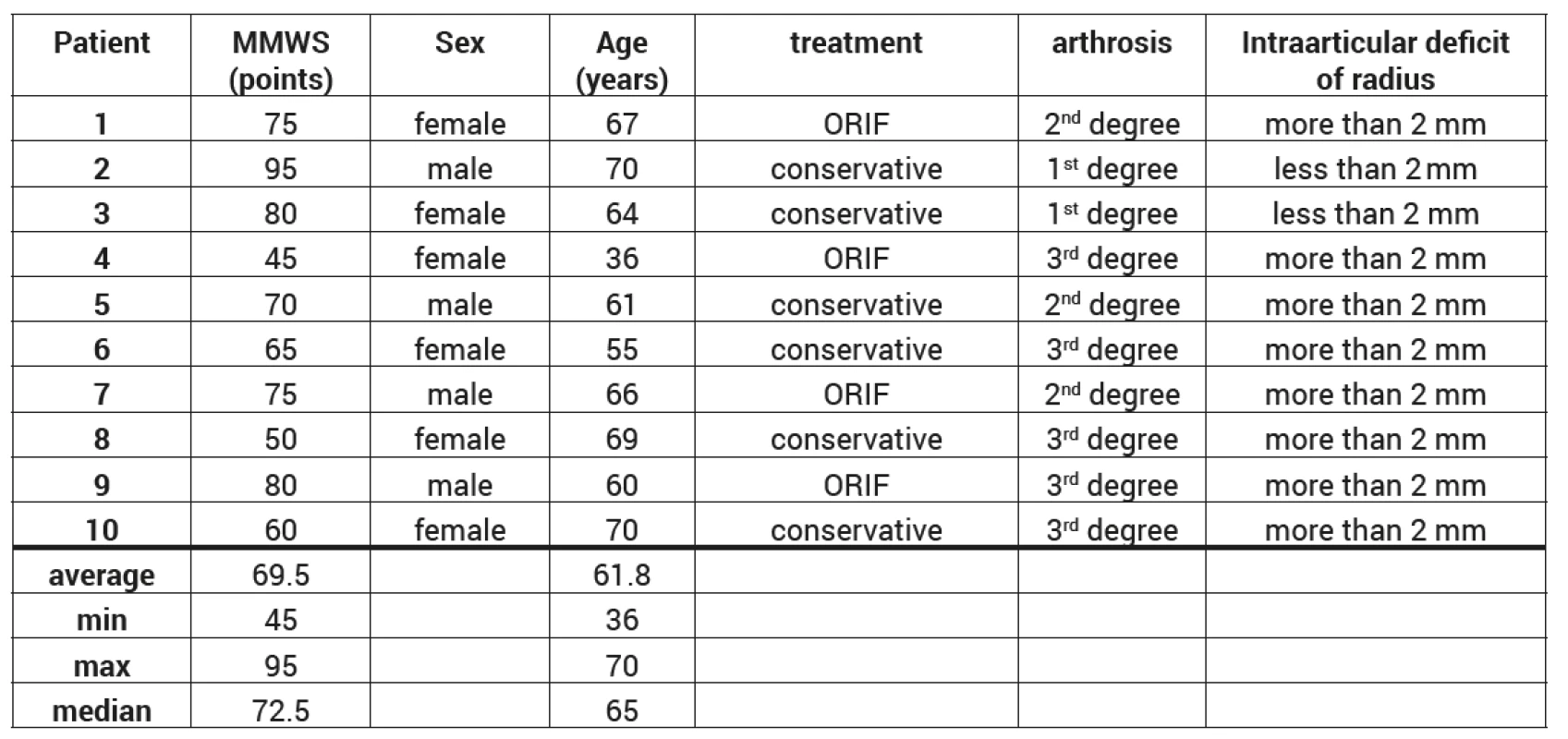
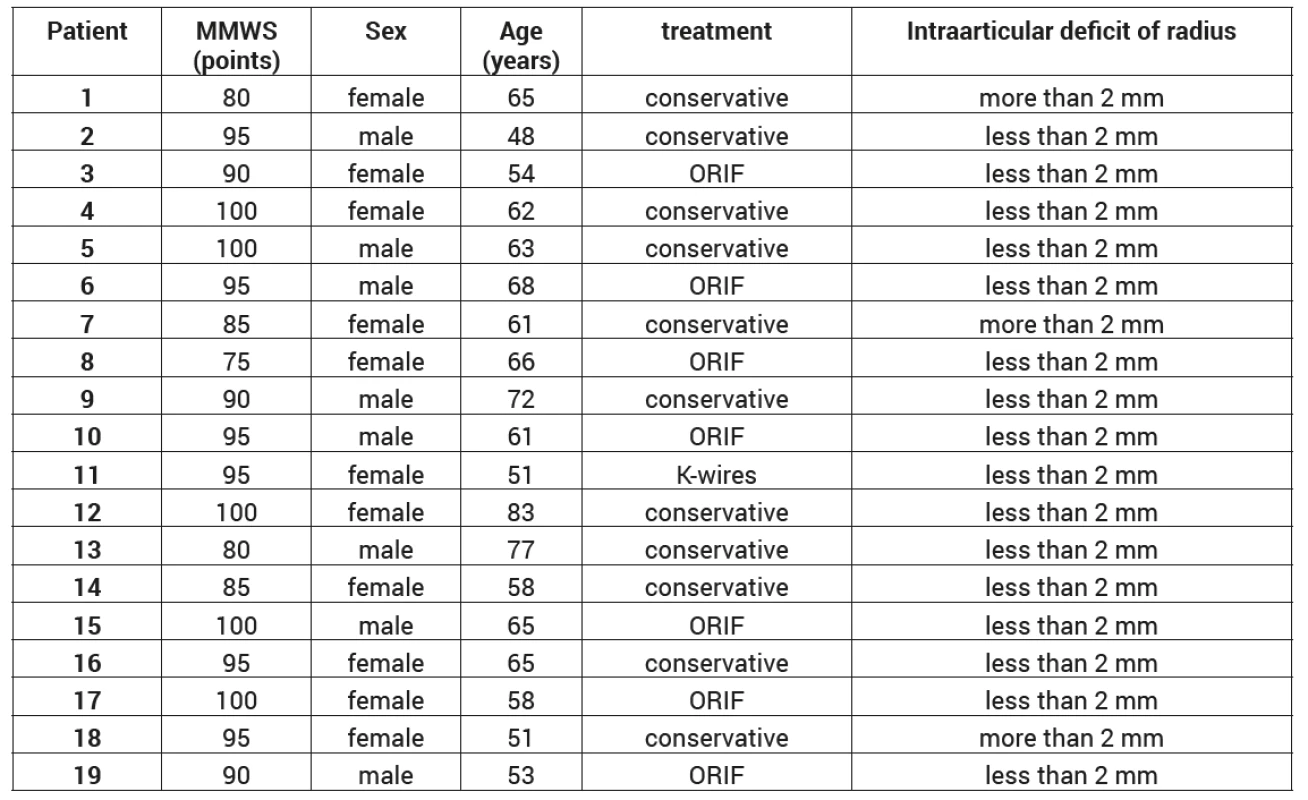
An intraarticular surface deficit in distal radius of more than 2 mm was observed in 11 patients examined (35.5 %). Radiocarpal arthrosis developed over 11–12 years in 8 patients with the articular surface deficit in the distal radius of more than 2 mm (72.7 %). Conservative procedure was chosen in all ten patients with radiocarpal arthrosis; despite subjective difficulties, none of the patients wished to have a surgery.
Discussion
Most of the literature on radiocarpal arthrosis deals with the surgical solution of symptomatic arthroses. Studies of short-term results of distal radius fractures are frequent. However, few studies address long-term therapy outcomes [23], like our study does.
The weak spot of our work is a lower number of monitored patients. However, after 10 years or more it is difficult to trace and check clinically more than one third of the patients.
If the arthrosis develops in both radiocarpal articulation and midcarpal joint, radiocarpal arthrodesis may be the method of choice. The post-trauma indications of arthrosis describe more frequent persistent pain and significant limitations in limb function [1, 8]. In these cases, total carpal replacement does not have good results either; patients are generally younger and with higher demands on wrist function, leading to early implant failure [5, 20]. Proximal carpectomy may be one of the other options when only the radiocarpal joint is impaired. In this surgery, however, the articular surface of fossa lunata of the distal radius must be preserved [14]. Also, it is possible to use a silicone implant replacement with or without an intercarpal arthrodesis. However, implant wear and silicone synovitis rank this performance among the less favourite ones [22].
Limited carpal fusions have also been suggested; almost every combination of intercarpal and radiocarpal fusion is described in the literature and tested in clinical practice [9, 26]. Some studies have shown that even a limited range of wrist mobility is sufficient for most activities [4, 19].
In a prospective study by Swedish authors, the consequences of distal radius fractures were observed in 63 patients. In 25 patients, healing occurred in an incorrect position, arthrosis was observed in 38 patients and processus styloidei ulnae nonunion was observed in 9 patients. Incorrect position resulted in a significant deterioration of the clinical score. The arthrosis and processus styloidei ulnae nonunion did not affect clinical scores, pain, or handgrip strength [2].
Charles Goldfarb describes in a set of 16 patients the development and worsening of the arthrosis in all patients after the osteosynthesis of intraarticular distal radius fractures during a 15-year follow-up. Despite the deterioration of the radiological finding, the functional results remain good and are not related to the degree of arthrosis. Only palmar extension is given into relation to the narrowing of the joint space [12].
A 2013 study by A. Bolmers compares long-term results of patients with type B and C distal radius fracture according to AO classification. At the check-up after 20 years on average, no difference in functional outcome was observed between patients with type B and type C fractures. The only statistic difference between the two groups was in volar angulation in the lateral image [3].
In a set of 43 distal radius intraarticular fractures in young adults, Knirk and Jupiter describe, on average after 6.7 year from the surgery, the development of radiocarpal arthrosis in 91 % of 24 fractures with a joint deficit of radius of more than 2 mm [15].
The long-term results after conservatively treated fractures of distal radius of all types according to the AO classifications are covered in a study from 2007. In Sweden, 66 patients with unilateral distal radius injury were evaluated after 9–13 years. 52 patients achieved a good functional result regardless of the type of fracture. 5 patients had a fracture healed with a joint deficit of 1–2 mm, but only one of them developed arthrosis [10].
Conclusion
Healing of an intraarticular fracture in dislocation results in an uneven load on the joint and leads to degenerative changes.
Distal radius fractures interfering with the radiocarpal joint with a deficit of more than 2 mm represent a risk factor for the development of post-traumatic arthrosis, leading to painful restriction in wrist function. Despite this finding, however, wrist function is often acceptable to patients, without the need of indication for surgery.
MUDr. Tomáš Ninger
Sources
- ADLEY, L., RING, D., JUPITER, JB. Health status after total wrist arthrodesis for posttraumatic arthritis. J Hand Surg Am. 2005, 30, 932–936. ISSN 0363-5023.
- ALI, M., BROGREN, E., WAGNER, P. et al. Association Between Distal Radial Fracture Malunion and Patient-Reported Activity Limitations: A long-term follow-up. J Bone Joint Surg Am. 2018, 100, 633–639. ISSN 0021-9355.
- BOLMERS, A., LUITEN, WE., DOORNBERG, JN. et al. A comparison of the long-term outcome of partial articular (AO type B) and complete articular (AO type C) distal radius fractures. J Hand Surg Am. 2013, 38, 753–759. ISSN 0363-5023.
- BRUMFIELD, RH., CAMPOUX, JA. A biomechanical study of normal functional wrist motion. Clin Orthop Relat Res. 1984, 187, 23–25. ISSN 1528-1132.
- CAVALIERE, CM., CHUNG, KC. A systematic review of total wrist arthroplasty compared with total wrist arthrodesis for rheumatoid arthritis. Plast Reconstr Surg. 2008, 122, 813–825. ISSN 1529-4242.
- COONEY, WP., BUSSEY, R., DOBYNS, JH. et al. Difficult wrist fractures: perilunate fracture-dislocations of the wrist. Clin Orthop Relat Res. 1987, 214, 136–147. ISSN 1528-1132.
- CRICO, JJ., HEARD, WMR., RICH, RR. et al. The mechanical axes of the wrist are oriented obliquely to the anatomical axes. J Bone Joint Surg Am. 2011, 93, 169–177. ISSN 0021-9355.
- DE SMET, L., TRUYEN, J. Arthrodesis of the wrist for osteoarthritis: outcome with a minimum follow-up of 4 years. J Hand Surg Br. 2003, 28, 575–577. ISSN 0266-7681.
- DRÁČ, P., ČIŽMÁŘ, I., HOMZA, M. et al. Excize člunkové kosti a čtyřrohá fúze zápěstí pomocí VA-LIF v léčbě degenerativních poúrazových změn zápěstního kloubu. Acta Chir Orthop Traumatol Cech. 2014, 81, 135–139. ISSN 0001-5415.
- FÖLDHAZY, Z., TÖRNKVIST, H., ELMSTEDT, E. et al. Long-term outcome of nonsurgically treated distal radius fractures. J Hand Surg Am. 2007, 32, 1374–1384. ISSN 0363-5023.
- GARCIA-ELIAS, M., LLUCH, A., FERRERES, A. et al. Treatment of radiocarpal degenerative osteoarthritis by radioscapholunate arthrodesis and distal scaphoidectomy. J Hand Surg Am. 2005, 30, 8–15. ISSN 0363-5023.
- GOLDFARB, CA., RUDZKI, JR., CATALANO, LW. et al. Jr. Fifteen-year outcome of displaced intra-articular fractures of the distal radius. J Hand Surg Am. 2006, 31, 633–639. ISSN 0363-5023.
- HAUS, BM., JUPITER, JB. Intra-articular fractures of the distal end of the radius in young adults: reexamined as evidence-based and outcomes medicine. J Bone Joint Surg Am. 2009, 91, 2984–2991. ISSN 0021-9355.
- INGLIS, AE., JONES, EC. Proximal row carpectomy for diseases of the proximal row. J Bone Joint Surg Am. 1977, 59, 460–463. ISSN 0021-9355.
- KNIRK, JL., JUPITER, JB. Intra-articular fractures of the distal end of the radius in young adults. J Bone Joint Surg Am. 1986, 68, 647–659. ISSN 0021-9355.
- LAULAN, J., MARTEAU, E., BACLE, G. Wrist osteoarthritis. Orthop Traumatol Surg Res. 2015, 101, S1–S9. ISSN 1877-0568.
- MEDOFF RJ. Essential radiographic evaluation for distal radius fractures. Hand Clin. 2005, 21, 279–288. ISSN 0749-0712.
- O’MEEGHAN, CJ., STUART, W., MAMO, V. et al. The natural history of an untreated isolated scapholunate interosseus ligament injury. J Hand Surg Br. 2003, 28, 307–310. ISSN 0266-7681.
- PALMER, AK., WERNER, FW., MURPHY, D. et al. Functional wrist motion: a biomechanical study. J Hand Surg Am. 1985, 10, 39–46. ISSN 0363-5023.
- PECH, J., VEIGL, D., DOBIÁŠ, J. et al. První zkušenosti s totální náhradou zápěstí naší konstrukce. Acta Chir Orthop Traumatol Cech. 2008, 75, 282–287. ISSN 0001-5415.
- PILNÝ, J., ŠVARC, A., HOZA, P. et al. Rozvoj artrózy po neléčené skafolunátní nestabilitě zápěstí. Acta Chir Orthop Traumatol Cech. 2010, 77, 131–133. ISSN 0001-5415.
- SMITH, RJ., ATKINSON, RE., JUPITER, J. Silicone synovitis of the wrist. J Hand Surg Am. 1985, 10, 47–60. ISSN 0363-5023.
- VAN SON, MA., DE VRIES, J., ROUKEMA, JA. et al. Health status and (health-related) quality of life during the recovery of distal radius fractures: a systematic review. Qual Life Res. 2013, 22, 2399–2416. ISSN 1573-2649.
- WAGNER, WF. Jr., TENCER, AF., KISER, P. et al. Effects of intraarticular distal radius depression on wrist joint contact characteristics. J Hand Surg Am. 1996, 21, 554–560. ISSN 0363-5023.
- WATSON, HK., BALLET, FL. The SLAC wrist: Scapholunate advanced collapse pattern of degenerative arthritis. J Hand Surg Am. 1984, 9, 358–365. ISSN 0363-5023.
- WATSON, HK., GOODMAN, ML., JOHNSON, TR. Limited wrist arthrodesis. Part II. Intercarpal and radiocarpal combinations. J Hand Surg Am. 1981, 6, 223–233. ISSN 0363-5023.
- WEISS, KE., RODNER, CM. Osteoarthritis of the wrist. J Hand Surg Am. 2007, 32, 725–746. ISSN 0363-5023.
Labels
Surgery Traumatology Trauma surgeryArticle was published in
Trauma Surgery
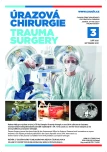
2020 Issue 3
Most read in this issue
- Traumatic dissection of the parent cerebral arteries
- Radiocarpal arthrosis after intraarticular fractures of distal radius
- Vzpomínka na primáře MUDr. Jana Housera (5. 10. 1947 – 11. 7. 2020)
- ROLE OF ENDOVASCULAR TREATMENT OF SPLEEN INJURY IN NON-OPERATIVE MANAGEMENT OF HIGH-RISK PATIENTS

